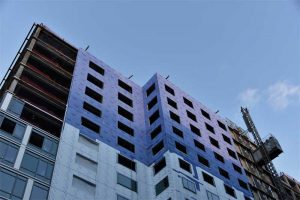
By Iltaz Alam
With concerns about sustainability, energy use, and indoor air health on the rise, the performance of a building envelope has never been more scrutinized. Considering how air leakage often leads to increased heating and cooling costs, air barriers play a crucial role in reducing air leakage and protect against mold and other unhealthy conditions for occupants and structures alike.
Using a fully adhered air barrier, whether sheet-applied or fluid-applied, is essential in creating a continuous barrier which will minimize air leakage. How well the membrane is bonded to the wall substrate will greatly affect the barrier’s performance. This adhesion is a critically important, yet often overlooked, factor in air barrier selection, and it impacts the building envelope’s performance from the day it is installed and throughout the life of the building.
Small leaks, big impact
Even a small air leak in a wall structure can have significant negative effects. Heated or conditioned air can escape through the wall, increasing HVAC loads and energy costs, but what is even more concerning is the issue of moisture transport, called vapor drive.
Moisture vapor naturally moves from a high concentration to a lower concentration, until it is in balance. If the vapor pressure is high outside the wall and low inside the wall, vapor drive will be directed inward and vice versa. The greater the difference of this vapor pressure or “concentration gradient,” the greater the vapor drive. Temperature differential between the outside and inside air also affects vapor drive; the greater the differential, the more vigorous the vapor drive.
Consider this: The air passing through a 25.4 mm (1 in.) hole in a wall transports a hundred times more water than vapor diffusion through a 1.23 x 2.5 m (4 x 8 ft) gypsum wallboard, however, this is while assuming interior temperature is 21 C (70 F) with 40 percent relative humidity (RH).1
When warm, moist air contacts cooler indoor air, it condenses and can accumulate in wall components, creating an ideal environment for mold growth. Moisture can saturate insulation, degrading its insulating properties, and can be absorbed by porous materials such as wood and gypsum, causing damage inside the wall which may not be visible. This makes the selection and proper installation of an appropriate air barrier pivotal.




